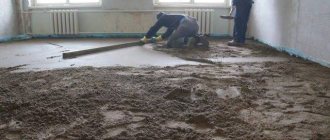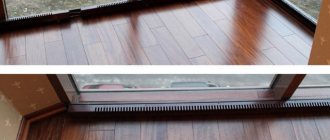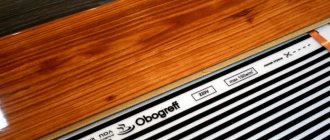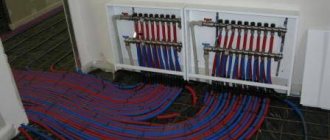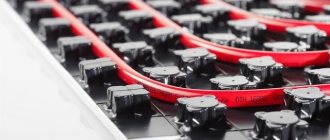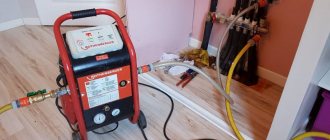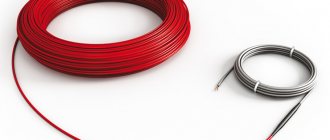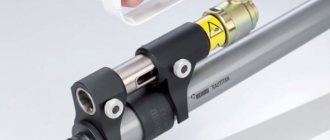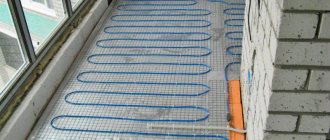Warm floors are an opportunity to provide maximum comfort in the home. Thanks to this system, you can easily control the temperature in the room and do not depend on central heating. But for this, installation must be carried out in full compliance with technology, and all materials must be correctly selected. One of the most important points is the installation of a protective top layer over the heating pipes. Having studied how and with what to fill a warm water floor, you can get to work.
How to fill a warm water floor
Wet screed
This option can be called traditional; it is often used to level the floor surface. In most cases, a solution is prepared from cement, sand and water.
The proportions of cement and sand in concrete for heated floors should be 1:3, and the cement should be of grade M400 or M500. It is not recommended to add gypsum powder to the solution, as this increases the hygroscopicity of the composition. As a result, even a slight decrease in floor temperature can cause condensation to form on its surface. In addition, gypsum is characterized by high thermal insulation properties, which is not entirely necessary for heated floors.
Installation
The screed on a warm floor is characterized by the presence of some features.
The process of pouring screed onto a heated floor takes the following steps:
- Along the entire perimeter of the room, at the joints of the floor and walls, edge tape is glued. It is designed to compensate for the thermal expansion of concrete.
- The minimum height of the screed is calculated with the corresponding marks. The overall height of the heated floor will depend on the nature of the solution used.
- The appropriate beacons are installed according to the height of the heated floor.
Measures are taken to prevent cracks from occurring.
How to prepare the mixture
To prepare high-quality concrete mortar, it is better to use coarse sand. Small grains of sand contribute to the formation of cracks in the screed under the influence of constantly changing temperatures. Such a defect is practically irreparable, while the heat transfer of the system decreases and the temperature in the room drops.
In order for the screed to be done efficiently, it is necessary to properly prepare the solution. To do this, you need to combine dry sand and cement, mix them thoroughly, and then add water. The liquid is added to the dry mixture for screeding a heated floor in small portions, mixing the composition well after each addition. The amount of water depends on the consistency of the solution required. It is very important that it does not spread over the floor surface, but has sufficient plasticity. You can start pouring the screed only after achieving the required plasticity and homogeneity of the solution.
Wet screed is popular among private and professional builders. During operation, not only the advantages of such a solution for screeding a heated floor began to emerge, but also its disadvantages. In particular, the following became known:
- The screed takes a very long time to dry, complete drying is achieved in 28 days. This is because the solution contains a large amount of water.
- During the process of pouring the screed, it is possible that voids may form, which are practically impossible to remove, since compaction can damage the heating elements of the heated floor.
- Drying of the screed is always accompanied by the formation of cracks. Reinforcement using a metal or polymer mesh helps to partially solve the problem. However, small cracks are always present on the surface.
- Leveling the screed is a labor-intensive process; for this it is necessary to install beacons and use a rule. After the mortar for screeding a warm water floor has dried a little, be sure to rub in the indentations and cut off the excess mortar.
How to pour a concrete screed
Choosing the type of screed to fill is not enough; you also need to know how to fill it correctly. Any mistake in the manufacture of such a coating reduces the effectiveness of heated floors and leads to the destruction of the screed. Before the pouring stage, work must be done to prepare the base, lay waterproofing and reinforcing layer, and install the heating system. The damper tape is also attached around the perimeter of the room before laying the heated floor. And only after this you can start making the screed.
How to make a heated floor screed. Scheme
Schematic diagram of the screed
To work you will need:
- metal profile for guides;
- dry gypsum;
- container for mixing the solution;
- level;
- trowel;
- rule.
Heated floor screed options
Step 1. Using a level gauge, mark the line for pouring the screed on the wall. Please note that the thickness of the mortar above the pipes should not be less than 3 cm.
Mixing the solution
Step 2. Mix the plaster mortar and use a trowel to spread it in small piles along one of the walls at a distance of 20 cm. Place guides on the mortar and level them. A distance of 1.5-1.8 m is left between the beacons. Since gypsum dries very quickly, you should not spread the beacon solution over the entire area at once, do it in 2-3 steps.
Step 3. Prepare a concrete solution: mix the dry components in the required proportions, pour in water, add a plasticizer.
The solution is poured between the guides and, using the rule, distributed over the surface
Step 4. When pouring the floor, the pressure in the pipes must be 0.3 MPa, otherwise the screed cannot be laid. The solution is poured between the guides and distributed over the surface using a rule. You need to work very carefully so as not to step on the pipes. Filling is done in portions, dividing the room into several sections. If the floor area is more than 40 m2, a damper tape 5-10 mm thick is laid between the sections. It is best to use a special intercontour tape that has a T-shaped profile. It has standard parameters: width 10 cm, height 10 cm and thickness 1 cm. The tape is produced in lengths of 2 m and is very inexpensive. It is much more convenient to install than regular tape. Expansion joints prevent the screed from cracking during thermal expansion. The pipes passing through the seams must additionally be covered with corrugation.
The photo shows an expansion joint and a pipe joint covered with corrugation
When the entire floor is filled, the screed is covered with polyethylene and left to dry. After a day, the beacons are removed and the recesses are sealed with mortar. Cover it again with film, and then periodically moisten the floor with water to prevent cracks from appearing. As soon as the screed has gained the necessary strength and the humidity level drops to 5-7%, the finishing coating can be laid.
Semi-dry screed
To reduce the number of shortcomings of a concrete screed, it is necessary to introduce plasticizers and additives into the screed for heated floors. Thanks to this, the properties of the solution change and drying time is reduced. In addition, additives allow you to use less water, which is why the screed is called semi-dry.
Using such a screed has several advantages:
- Short drying time due to small amount of liquid.
- Getting a smoother surface.
- Increasing the water resistance of concrete, which is especially important for floors in bathhouses, bathrooms and kitchens.
- Maintaining plasticity for a long time, which allows you to mix a larger amount of solution.
- The plastic mixture for filling the heated floor is laid more densely, filling the voids as much as possible. As a result, the screed is characterized by uniformity and higher heat transfer.
- During the maturation of the screed, cracks do not appear, since shrinkage is practically absent.
- The surface can be used within 12 hours.
- In most cases, the topcoat can be installed after 28 days, and when certain additives are added to the solution, after 7 days.
This method also has disadvantages, including the following:
- Higher cost of some mixtures for heated floors.
- Significant coefficient of vapor permeability.
- Long initial setting of the solution. In this case, the problem can be solved using a special hardening accelerator.
For semi-dry screed, you can use a ready-made mixture for heated floors, to which it is enough to add a certain amount of liquid in accordance with the instructions on the package. In addition, you can purchase plasticizers separately and add them to the solution at your discretion. All dry mixtures for heated floor screed contain certain components, so you should follow the manufacturer's recommendations for preparing a solution for semi-dry screed.
One of the modern methods of reinforcing a concrete screed for a heated floor is adding fiber fiber to the solution. As a result, the strength of concrete increases significantly, and its water permeability, on the contrary, decreases, and the formation of cracks is also prevented. The effectiveness of the additive is quite high, so damage to the heating elements is completely eliminated. In addition, a smoother and more attractive surface is noted.
The use of fiber fiber is carried out according to a certain scheme. If the solution is prepared in a concrete mixer, then the additive is introduced a few minutes before it is ready. When kneading by hand, the component is added to the dry ingredients and the mixture is brought to homogeneity. After this, they begin to pour in water in small portions. For a high-quality screed, 900 grams of additive per cubic meter of finished mortar is sufficient. Despite the high cost of fiber fiber, its addition significantly increases the heat transfer of the surface.
If it is not possible to use fiberglass, then the quality of the screed is improved by laying a metal or polymer reinforcing mesh. The choice of material depends on the type of heated floor: for water floors it is recommended to use a metal mesh, for electric floors - from polymer materials. Also sometimes they make a dry heated floor, which eliminates the use of various solutions.
Types of plasticizers
To give the cement-sand mortar certain properties, special additives are used - plasticizers, which have different compositions and shapes.
Plasticizers are available in dry or liquid form. Liquid additives are supplied to retail outlets in canisters, the volume of which can be completely different. Before use, such a plasticizer must be thoroughly shaken and added to the dry mixture along with the liquid. In most cases, about 1.5 liters of additive are used per 100 kg of cement.
If a dry plasticizer is purchased for work, then immediately before adding it to the concrete composition for a warm floor, it should be diluted with water. The proportions of water and additives are indicated on the packaging; in most cases, craftsmen take one part of the dry component and two parts of water. The diluted mixture must be left to infuse for several hours. After a certain time, the composition is mixed and added to the concrete to screed the heated floor.
It is important to understand that the solution for screeding a heated floor with the addition of a plasticizer is prepared using a small amount of liquid. Therefore, you should approach the preparation process very responsibly and carefully read the instructions on the packaging from the manufacturer.
Each additive in the mortar for heated floor screed is designed to improve certain properties, however, most of the additives are added to more completely dissolve cement particles. This allows you to obtain a more uniform and durable composition. Some additives make concrete waterproof, a quality that is especially important for floor surfaces in areas with high humidity. There are also additives that can reduce the amount of cement in the solution by up to 20% while maintaining the strength characteristics of the concrete screed for heated floors.
When choosing a plasticizer, special attention should be paid to the quality of the additive and carefully study the scope of its application. In particular, the additive must be compatible with heated floors.
As for the cost, different brands of underfloor heating solution cost different things. It cannot be said that the price is too high, since the consumption of plasticizer is insignificant.
Laying technology
The process of pouring a floor slab may differ for rooms of different purposes and layouts. The general scheme for laying the screed consists of several stages:
- cleaning the floor up to cleaning the concrete base;
- filling the leveling screed. If the floor slab is uneven in thickness, it may collapse prematurely due to temperature changes across its volume;
- laying a film (prevents the solution from leaking to the lower floors) and a layer of foam plastic (increases the efficiency of heat transfer to the upper part of the floor). A heat-insulating (reflective) film is sometimes placed on top of the foam;
- installation of the selected heating system;
- pouring a solution prepared in advance. Expansion joints must be provided between the walls and the screed to compensate for cycles of expansion and compression. For the same purpose, intermediate shock-absorbing seams are laid in a large room.
Read below about the brand of mortar for underfloor heating screed.
Dry screed for heated floors
Not always and not everyone has the opportunity to mix components, select and add plasticizers. In this case, a ready-made mixture for heated floors, which is designed specifically for this case, comes to the rescue. In this composition, all components are measured in a certain proportion and mixed to the desired consistency. You just need to pour in water, mix and achieve homogeneity of the solution.
The advantage of dry mixtures for warm water floors is the ability to choose the composition for a specific floor covering. Their disadvantage is their rather high cost compared to similar home-made materials. Therefore, if you have a sufficient budget, you can purchase a dry mixture; if you want to save money, you can knead the solution yourself. However, in any case, it is recommended to use a dry screed as the final leveling layer.
The “warm floor” system requires the presence of a cement screed. What solution is needed for a heated floor - this issue can be resolved at your own discretion and depending on your financial capabilities.
Features of electric underfloor heating with heating cable
Maria A Member of FORUMHOUSE
I have a house with an unheated basement. The ceiling is concrete slabs. I want to make an electric heated floor on the first floor in the kitchen and hallway under the tiles. I thought: what kind of warm floor should I choose, what layers does the correct “pie” consist of? Is it necessary to install insulation under a warm floor and what kind? How to properly make and fill a screed.
To answer these questions, you first need to understand the types of electric heated floors.
1. Film heated floor. It is laid directly (“dry”) under the final finishing floor covering - laminate, carpet or linoleum. Among the advantages, we note: the minimum thickness of the system and high installation speed. Disadvantages - such a warm floor cannot be placed under tiles in “wet rooms”, because the film is afraid of moisture and aggressive alkaline solutions - tile adhesive or sand concrete-based screed.
The finished floor covering (for example, laminate) must be certified for use with a heated floor system and allow heating.
2. Heating mats (thermomats). This is a finished product with a certain, calculated cable pitch, in durable insulation, laid in a mesh. This simplifies the calculation of the power of the heated floor and reduces the time for installing the entire system. Most often, heating mats are chosen when it is not possible to increase the height of the floor and pour a full screed, and the mats are mounted directly into the layer of tile adhesive.
Heating mats are produced with a certain width and multiplicity of heating area 0.5 m², 1 m², 2 m², etc.
For example, for dry, insulated rooms and as a heating system additional to the radiator, the power of thermomats is selected at the rate of 120 - 140 W/m². For the main heating system - at least 150 W/m². For rooms with high humidity and non-heat-insulated rooms - 180 - 200 W/m².
The power of the heating system is calculated based on the heat loss of the house, which it must compensate.
3. Warm floor based on a heating (single-core or two-core) cable in a shielding braid, which minimizes the level of electromagnetic radiation.
Anna Ruzhitskaya Product Manager at LafargeHolcim
A heating cable is usually cheaper than a thermomat. Using a cable, you can vary the power of the underfloor heating system per square meter by adjusting the pitch of the cable on the mounting tape. Unlike heating mats, which are laid in a thin layer (about 5 mm) of tile adhesive, the heating cable is embedded in a screed made of cement-based mortar (sand concrete) 3-6 cm thick, which accumulates heat well (the inertia of the system increases).
The thicker the screed, the longer it takes to cool, but also the longer it heats up, because... a heating cable laid in a sand concrete screed needs much more time to completely warm up the room and the floor covering itself. When using heating mats located directly in the adhesive layer under the tile, heating of the coating (the system reaches operating mode) occurs much faster.
Important: when choosing a heated floor system between thermomats and a heating cable, you should remember that the height of the floor (the thickness of the entire structure when using a cable) will be raised by at least 4.5 cm, taking into account the thickness of the screed (about 3 cm), tiles (1 cm) and tile adhesive (0.5 cm). You can turn on a warm floor made from heating mats within 10-14 days after laying the tile adhesive. When using a heating cable and sand concrete screed, this period increases to 21-28 days, because The sand concrete screed must gain the necessary strength.
